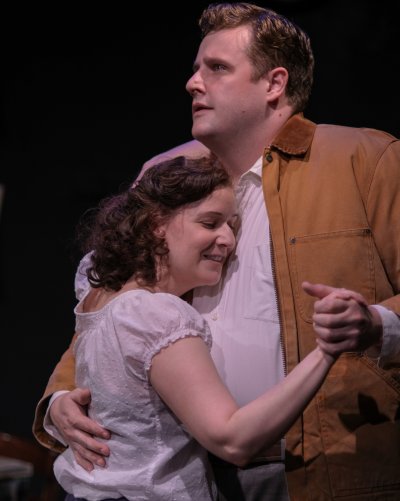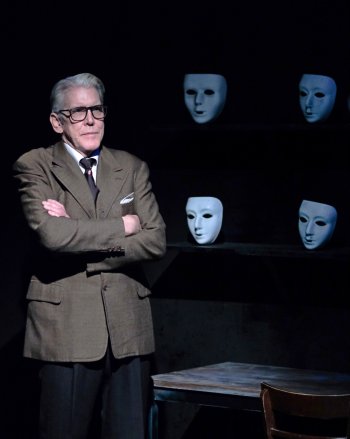Radium Girls
Ambitious stage play attempting to tell the true story of the cases of “the Radium Girls” and their subsequent lawsuits.

Olivia Killingsworth and Kyle Maxwell in a scene from D.W. Gregory’s “Radium Girls” now at Metropolitan Playhouse (Photo credit: Brian Lau)
[avatar user=”Victor Gluck” size=”96″ align=”left”] Victor Gluck, Editor-in-Chief[/avatar]
The true story of what has been dubbed the “Radium Girls” is a fascinating tale of greed, complacency and miscarriage of justice. After the remarkable discovery by Marie and Pierre Curie of the radioactive metal, the United States Radium Corporation of Orange, New Jersey, hired young women to use radium paint to coat the dials of clocks so that they would glow in the dark. The girls were required to wet the paint brush with their lips causing them to ingest a high percentage of the paint. While radium in small doses could be used to kill cancer cells, ingesting led to all kinds of painful deaths for which the company took no responsibility for this work which began in 1917 and resulted in lawsuits brought in 1927 and 1928.
D.W. Gregory’s docudrama Radium Girls being given its New York premiere after a run in New Jersey over 20 years ago attempts to put the story and subsequent lawsuits on stage. Part of the problem with the stage version is the use of ten actors to play 36 parts with five playing up to seven roles each, making it difficult to keep straight who is who. Possibly more damaging is the languid, studied direction by Laura Livingston. The second act which leads up to the lawsuits is somewhat quicker and more engaging but at two hours and 20 minutes the play is too crammed with characters and data for its own good. A recent film based on the same story appears to have been defeated for other reasons.

Kelly Dean Cooper and Michelle Bagwell in a scene from D.W. Gregory’s “Radium Girls” now at Metropolitan Playhouse (Photo credit: David Schulder)
The lead actors are rather colorless in underwritten, one-dimensional roles. Radium Girls puts one in mind of the film of Erin Brockovich which had a charismatic central performance which brought dramatic focus to a similar type of case. Vincent Gunn’s minimal set with tables and chairs and shelves on the back wall has no atmosphere at all but it does allow for swift transitions between the seemingly countless scenes. While the lighting by Heather M. Crocker uses green lights affixed to the ceiling of the theater, they never cast the eerie glow that would have been so much more effective.
Radium Girls has 28 scenes of which several use a split stage effect to have two things going on simultaneously. In its present form, it is actually not very conducive to the stage but is likely a film script or teleplay which could handle the many locations and multitude of characters more successfully. The play begins with Grace Fryer, one of the five radium girls who eventually brought the lawsuit against the United States Radium Corporation, and alternates between her story and that of the company’s CEO Arthur Roeder.

Depicting events from 1917 – 1928, plus a coda set in the 1940’s, we meet officers, board members, doctors and dentists in cahoots with the company who blame the girls for poor dental hygiene, diagnose syphilis and bury scientific reports on the deleterious effects of radiation exposure. We also learn about the cases of Kathryn Schaub, Irene Rudolph and Amelia Maggia. We meet Katherine Wiley, Chair of the Consumer’s League of New Jersey which gets the girls’ case going, Raymond Berry, the prosecuting attorney who takes the case on contingency, and Edward Markley, counsel for the company who continually stalls with various delaying tactics. We also meet Grace’s mother and her boyfriend Tom who is at first supportive. Reporters make periodic appearances to update us on breaking news in the case.
As the dying Grace Fryer, Olivia Killingsworth never makes her illness or pain real, while Kelly Dean Cooper as Roeder, ultimately the villain of the piece, is too bland and neutral to trigger the desired reaction. Marie Lenzi, Benjamin Russell, Kyle Maxwell, Michelle Bagwell and David Logan Rankin play so many characters each, both good and bad, that it is difficult to follow who is who, including Rankin also playing society woman Mrs. Middleton in drag which adds an unneeded touch of parody. As radiation victim Katherine Schaub, Grace Bernardo is much more effective as a strong-willed woman, determined not to be a victim, while Kate Falk as her fellow worker Irene Rudolph disappears so quickly as to make little impression. Sydney Badway as victim Amelia Maggia shows up but has no lines.

David Logan Rankin in a scene from D.W. Gregory’s “Radium Girls” now at Metropolitan Playhouse (Photo credit: Brian Lau)
One effective device is that white face masks are placed on shelves on the back wall of the set as each of the victims dies. A coup de theatre occurs in the final moment when they glow in the dark as the lights come down on the second act curtain. It is a shame that the production did not have more clever effects like this. While the story retains its power, D.W. Gregory’s Radium Girls does not do it justice nor report the final irony that this went on almost another two decades.
Radium Girls (through November 21, 2021)
Metropolitan Playhouse, 220 E. 4th Street, between Avenues A and B, in Manhattan
For tickets, call 212-995-8410 or visit http://www.metropolitanplayhouse.org
Running time: two hours and 20 minutes with one intermission






Your review of the play makes it perfectly clear what worked and what didn’t work–and for what reasons.